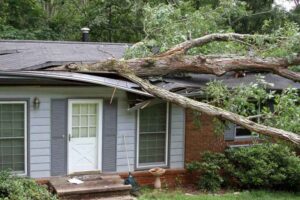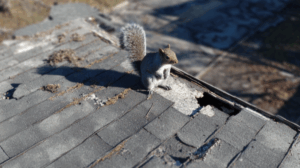Most of us put off what we can’t see. That’s especially true with storm damage. A few missing shingles? Maybe. But if there’s no visible leak or ceiling stain, many homeowners just move on with life. But here’s the thing: roofing systems don’t always show damage right away. And by the time you notice it, you could be looking at major repairs, not to mention a more complicated insurance claim.
In coastal towns like Bethany Beach, DE, storm damage happens fast—and spreads quietly. That’s why it pays to know how to inspect, document, and act quickly. This guide will show you how to approach a proper roof storm damage assessment, avoid common mistakes, and protect both your home and your wallet.
What You’ll Learn in This Blog
- Why even minor roof issues can lead to expensive emergency repairs
- How coastal weather in places like Milton and Bethany Beach, DE affects your roof faster than you think
- What to prepare before you file a storm damage roof insurance claim
- How to spot and document damage for your insurance company
- How Grand Exteriors helps you inspect, report, and repair storm damage
Need support right away? Schedule your free inspection with Grand Exteriors.
Why Delaware Roofs Face Bigger Risks After a Storm
Let’s talk about real conditions. Homes near the Delaware coast get hit harder and more often by high winds, salt air, and heavy rainfall. You may not notice much damage from the ground, but over time, these conditions weaken your roofing system faster than you expect.
Coastal weather wears down sealants, curls shingles, corrodes flashing, and lets in moisture around vents and eaves. The result? What starts as a loose shingle could become a rotted roof deck in just one season.
That’s why storm damage assessments in areas like Bethany Beach, DE aren’t optional—they’re essential. And if you plan to file a storm damage insurance claim, documentation is your best tool.

What You Need to Do Before Your Roof Inspection
Before you inspect your roof or contact your insurance company, a little preparation goes a long way. Here’s what we recommend:
- Know your policy – Understand what’s covered, how deductibles work, and what qualifies as “storm damage.”
- Document the storm – Record the date of the event, take photos of the area, and save any alerts or weather info.
- Gather tools – Use your smartphone, flashlight, and binoculars if you don’t have roof access.
- Protect yourself – Avoid walking on a wet or unstable roof. Safety always comes first.
- Call a local roofing expert – A company like Grand Exteriors can spot damage you might miss—and help you file properly.
How to Perform a Storm Damage Roof Inspection
Let’s walk through the process. These steps help you find problems early, collect evidence, and decide your next move.
Step 1: Walk the Property After the Storm
Start on the ground. Look for signs like:
- Shingle debris in your yard
- Dented or detached gutters
- Bent flashing or visible roof damage
- Tree limbs on or near the roof
- Water stains on exterior walls or soffits
This is your first chance to spot something out of place.
Step 2: Check the Attic or Ceiling
Storm damage isn’t always external. Grab a flashlight and head into the attic. Look for:
- Damp or sagging insulation
- Water spots on rafters
- Mold or mildew odors
- Daylight showing through roof boards
These signs usually mean your roofing system has already been compromised.
Step 3: Take Photos of Everything
Your insurance claim will rely heavily on photo documentation. Get:
- Wide shots of your home and rooflines
- Close-ups of visible damage
- Interior shots of attic or ceilings
- A brief video walkthrough if possible
Save everything with clear labels and dates.
Step 4: Call a Trusted Local Roofer
Grand Exteriors offers full storm damage assessments, which include:
- A professional inspection within 24–48 hours
- Written estimates for repairs
- Photos formatted for insurance documentation
- Support with your storm damage roof insurance claim
This way, you don’t have to navigate it all on your own.
Why Acting Fast Protects More Than Your Roof
Many homeowners wait to call a contractor until water starts dripping from the ceiling. But by that point, the damage is already widespread.
Here’s what we’ve seen happen when inspections are delayed:
- Insurance pushback – Carriers deny or reduce coverage due to late reporting
- Warranties voided – Manufacturers often require timely inspection after major weather events
- Bigger repairs – A loose flashing today becomes a rotten roof deck tomorrow
- Interior damage – Water intrusion affects drywall, insulation, and even electrical systems
All of this is preventable—with a prompt roof storm damage assessment and proper documentation.
If you want a deeper look at how small delays can create big repair bills, read our guide: The Hidden Cost of Waiting on Roof Repair. It outlines what happens when homeowners wait too long to act—and how to avoid those mistakes.
How Grand Exteriors Helps Delaware Homeowners
At Grand Exteriors, we specialize in helping coastal homeowners navigate storm damage repair and insurance claims. When you work with us, you get:
- Fast response—inspections within 48 hours
- Coastal-grade materials designed for wind and salt exposure
- Clear documentation and photos for claims
- Licensed, insured roofers with years of local experience
- Support from inspection to final cleanup
We work with you and your insurer to make sure nothing gets overlooked—and nothing gets delayed.

Delaware Roofing Claims and Storm Damage Questions Answered Clearly
We often get questions from homeowners in Bethany Beach and across coastal Delaware after storms hit. If you’re unsure about what to do next, these answers will help you move forward with confidence.
How soon should I inspect my roof after a storm?
You should inspect your roof within 1–3 days after a storm. Quick action helps you spot early damage, prevent interior leaks, and submit a timely insurance claim if needed.
What’s included in a roof storm damage assessment?
A roof storm damage assessment includes a full inspection of shingles, flashing, vents, gutters, and attic areas. It’s designed to identify both visible and hidden issues caused by wind, rain, or debris.
Does my homeowners insurance cover storm damage?
Yes, homeowners insurance typically covers storm-related roof damage—but only if the damage is reported promptly. Most policies exclude wear and tear or delayed claims, so documentation is key.
Should I repair roof damage before filing a claim?
You should only make emergency repairs like tarping the roof to prevent more damage. Full repairs should wait until your adjuster completes their review and your claim is filed.
Can Grand Exteriors help with my storm damage roof insurance claim?
Yes, Grand Exteriors helps homeowners with every step of a storm damage roof insurance claim. We provide inspection reports, repair estimates, and photo documentation, and we work directly with your adjuster if needed.
What if I don’t see visible damage—should I still schedule an inspection?
Yes, even if you don’t see visible damage, you should still schedule an inspection. Storms can cause hidden damage to roof layers or attic systems, and catching those issues early can prevent costly repairs later.
Final Thoughts: Don’t Wait to Check for Storm Damage
Storms move fast—and so does the damage they leave behind. What looks fine today may already be failing beneath the surface. The best way to stay ahead of repairs and insurance headaches is a simple one: act quickly, document everything, and call a trusted pro.
At Grand Exteriors, we help homeowners in Bethany Beach, DE and beyond with fast, honest roof inspections and full support through the insurance claim process. No pressure. No guesswork. Just clear answers and quality work.
Schedule your free storm damage assessment today and let’s make sure your roof is storm-ready—and claim-ready.




